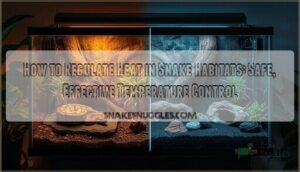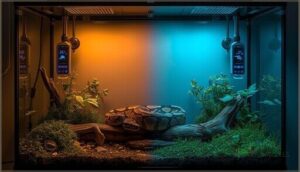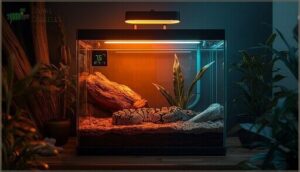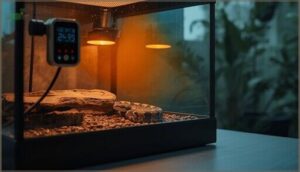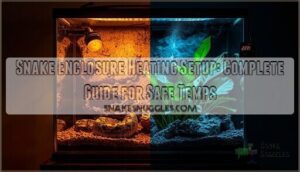This site is supported by our readers. We may earn a commission, at no cost to you, if you purchase through links.
A snake that can’t escape its own enclosure’s heat will cook from the inside out—neurological damage starts long before you see visible distress. Most keepers focus on hitting the right temperature numbers, but the real key in regulating heat in snake habitats isn’t about perfect degrees; it’s about creating choices.
Wild snakes constantly shuttle between sun-warmed rocks and cool burrows, fine-tuning their body temperature dozens of times per day. Your captive snake needs that same autonomy.
Whether you’re setting up for a ball python that wants a cozy 88°F basking spot or a garter snake comfortable at 80°F, the principles remain constant: establish clear thermal zones, monitor relentlessly, and never assume your heat source is behaving as advertised.
Small errors in heat regulation compound quickly, turning a thriving snake into a stressed one within days.
Table Of Contents
Key Takeaways
- Creating a thermal gradient with distinct warm and cool zones is more critical than hitting exact temperature numbers, because snakes need the autonomy to shuttle between zones and self-regulate their body temperature just as they do in the wild.
- Overheating causes irreversible neurological damage before visible symptoms appear, while prolonged cold stress suppresses immunity and digestion, making reliable monitoring with digital thermometers and thermostats non-negotiable for preventing life-threatening temperature extremes.
- Heat sources like mats, ceramic emitters, and radiant panels each serve different enclosure designs, but all require thermostat integration and strategic placement to maintain species-specific temperature ranges—typically 80–88°F for most captive snakes—without creating dangerous hot spots or cold zones.
- Seasonal adjustments, humidity management, and backup heating plans are essential because ambient temperature shifts and power failures can destabilize even well-designed setups, threatening your snake’s thermal stability and survival within hours.
Importance of Heat Regulation for Snakes
Keeping your snake’s habitat at the right temperature is essential for its health and well-being. Every species has unique needs, so choosing the right setup matters.
Let’s look at the best options for safe and effective heat regulation.
Effects of Temperature on Snake Health
When your snake’s habitat temperature drifts from its ideal range, you’ll notice real changes—lethargy, poor feeding, and even immune suppression. Metabolic rate drops, digestion slows, and respiratory health suffers. Behavioral changes signal discomfort, while thermal injury risks rise.
Stable temperatures support healthy activity levels, proper shedding, and overall wellbeing, making temperature requirements a cornerstone of responsible reptile care. Corn snakes thrive when provided with a proper temperature gradient.
Species-Specific Temperature Requirements
Just as you wouldn’t wear a winter coat in July, each species demands its own ideal temperatures. Boa Temperatures peak at 29–35°C, while Python Temperatures reach 32–35°C. Garter Temperatures hover around 28–32°C, and Colubrid Temperatures run slightly cooler. Hot-Spring Snakes thrive in extreme warmth.
Matching these temperature requirements in your snake enclosure ensures healthy thermoregulation and wellbeing. Maintaining these temperatures is essential, as snakes, being ectothermic, require external heat sources to regulate their body temperature.
Risks of Improper Heat Regulation
Getting temperature wrong isn’t just uncomfortable—it’s dangerous. Overheating risks include dehydration, thermal burns, and even neurological damage, while cold stress slows digestion and weakens immunity. Sudden temperature fluctuations spike mortality rates and trigger rapid health declines.
Temperature extremes threaten your snake’s life—overheating causes burns and neurological damage, while cold stress weakens immunity and digestion
Without thermostats and a proper temperature gradient, you’re gambling with your reptile’s care, risking overheating and underheating every day.
Creating a Temperature Gradient in Enclosures
Creating a temperature gradient is the backbone of a healthy snake enclosure. Your snake relies on both warm and cool zones to regulate its body temperature and stay active.
Let’s look at the main ways you can set up these essential zones in your habitat.
Why Snakes Need Temperature Gradients
Imagine your snake’s enclosure as a landscape with sun and shade. Without a thermal gradient, you risk temperature stress and poor captive welfare.
A temperature gradient lets your snake practice behavioral thermotaxis, moving from a basking spot to a cool side as needed. This aids digestion efficiency and prime metabolic rates, essential for health and natural activity in captivity.
Designing Warm and Cool Zones
When you set up your snake enclosure, Zone Placement is key to achieving a stable thermal gradient. Consider these factors for effective warm and cool zones:
- Adjust Substrate Depth for heat absorption and comfort
- Choose Enclosure Size to support natural movement
- Position heat sources for a clear temperature gradient
- Factor in Seasonal Shifts and Species Needs to maintain safe, healthy zones
Monitoring Gradient Effectiveness
How do you know your temperature gradient is truly working? Reliable monitoring matters. Use multiple digital thermometers for accurate enclosure temperature readings, and log data to track gradient stability over time. Pay attention to behavioral indicators—if your snake consistently seeks out specific zones, the thermal gradient is effective. Remote monitoring systems add peace of mind, letting you adjust conditions anytime.
| Technique | Key Benefit |
|---|---|
| Thermometer Placement | Precise temperature data |
| Behavioral Indicators | Real-time snake feedback |
| Temperature Logging | Tracks gradient trends |
Choosing The Right Heat Source
Finding the right heat source for your snake’s habitat is essential for its health and comfort. Each option works a bit differently and suits different setups.
Here’s what you need to know before you make your choice.
Heat Mats and Pads
Ever wondered why heat mats and heating pads are favored for reptile enclosure temperature control? When placed correctly—covering about one-third of the floor—they create a necessary temperature gradient.
Mat safety hinges on thermostat integration and smart placement strategies. These energy-efficient tools support digestion and stress reduction, delivering health benefits while minimizing humidity loss and keeping your snake’s environment stable and secure.
Ceramic Heat Emitters and Bulbs
Ceramic heat emitters offer energy efficiency and a long emitter lifespan, making them a reliable heating solution for reptile enclosure heating. Unlike heat lamps, they don’t disturb your snake’s day-night cycle.
Popular models like Fluker’s and Zoo Med provide safe options, but always follow safety guidelines—mount above mesh, pair with a thermostat, and monitor humidity impact for ideal temperature gradients.
Radiant Heat Panels and Cables
Radiant panels distribute heat evenly across your snake enclosure, eliminating cold spots while using 40-60 watts for typical setups. Their safety features include auto shut-off and out-of-reach mounting, preventing burns.
Heat cables offer flexible installation under substrates, creating precise temperature gradients. Both require thermostats for best temperature control and provide energy efficiency with minimal maintenance needs compared to traditional heat mats.
Heat Lamps and Their Uses
Heat lamps create a focused basking spot that mimics natural sunlight, encouraging healthy thermoregulation in your snake’s reptile enclosure. You’ll need to select appropriate wattage—50 watts for small setups, 100-150 watts for larger ones—to maintain an effective temperature gradient.
Mount bulbs outside the enclosure using ceramic sockets to prevent burns, and always pair with thermostats for lamp safety while managing energy costs efficiently.
Monitoring and Adjusting Habitat Temperature
Installing the right heat source is only half the battle—you need to know what’s actually happening inside your snake’s enclosure. Accurate monitoring tools and smart adjustments keep temperatures stable and your snake healthy.
Let’s look at the essential equipment and strategies that give you complete control over your habitat’s thermal environment.
Using Thermometers and Hygrometers
Without accurate thermometers and hygrometers, you’re basically guessing at your snake’s environmental needs. Digital thermometers outperform analog models in precision, while digital hygrometers track species humidity requirements ranging from 50% to 70%.
Probe placement matters—position sensors on basking surfaces and in cool zones to detect temperature fluctuations. Multi-sensor setups provide thorough monitoring, though calibration needs periodic attention to maintain accuracy and prevent health complications.
Automated Temperature Control Systems
If manual monitoring feels tedious, automated temperature control systems solve that problem with precision thermostats that maintain stable enclosure temperature. These devices support multiple heat sources, regulate temperature gradients within ±1°C, and offer remote monitoring through smartphone apps.
Key features include:
- Programmable day/night cycles mimicking natural conditions
- Safety features with automatic shutoffs preventing dangerous spikes
- Energy efficiency reducing electricity costs by 20-30%
- Water-resistant probes for accurate readings in humid reptile enclosures
- System reliability through real-time alerts and data logging
Cost analysis shows initial investment pays off through reduced health risks and lower energy bills.
Preventing Overheating and Cold Spots
Even with automation, you’ll need to watch for temperature extremes that threaten your snake’s wellbeing. Overheating above 80°F risks neurological damage, while cold spots below 67°F stress species requiring warmth. Thermostats prevent dangerous spikes, but equipment placement matters—position multiple probes throughout your reptile enclosure to catch localized problems.
Proper temperature gradient design with strategic heat source positioning eliminates cold zones, while burn prevention measures—guards, thermostat controls—stop overheating disasters before they happen.
| Risk | Prevention Strategy |
|---|---|
| Burns from direct contact | Shield heat sources; use thermostats with cutoffs |
| Uneven thermal gradients | Combine belly and overhead heating in tall enclosures |
| Heat loss overnight | Improve insulation methods; adjust substrate depth |
| Equipment failure | Install backup systems; daily manual checks |
Seasonal and Environmental Considerations
Your snake’s habitat doesn’t exist in a bubble—it’s affected by the seasons and the weather around you. What works in July might leave your snake struggling in January, and a sudden cold snap can throw off even the best setup.
Let’s walk through how to adapt your heating strategy throughout the year and handle whatever Mother Nature throws your way.
Adjusting for Seasonal Temperature Changes
As ambient temperatures shift through the year, you’ll need to adjust your snake enclosure accordingly. Gradual adjustments—raising or lowering basking temperatures by a few degrees weekly—prevent stress while supporting behavioral stability.
Increase wattage or add seasonal heat sources during colder months, and use thermostats to prevent temperature fluctuations. Photoperiod changes, from 14-hour summer days to 8-hour winter cycles, mimic natural conditions.
Insulation importance increases in winter, helping maintain stable enclosure temperature despite external shifts.
Managing Humidity and Ventilation
Maintaining the right humidity levels works hand-in-hand with temperature control, directly influencing your snake’s respiratory health and shedding success. Balanced ventilation design prevents harmful moisture buildup while retaining species-appropriate conditions.
Proper humidity’s impact extends beyond comfort—it protects against retained sheds and respiratory infections.
- Misting frequency should match your snake’s natural habitat—tropical species need daily attention
- Substrate moisture retention varies; sphagnum moss outperforms newspaper for humidity-dependent snakes
- Install a digital hygrometer to track monitoring parameters accurately, adjusting as needed
- Position vents strategically: lower on cool sides, upper on warm zones for best airflow
Adapting to Extreme Weather Events
When power outages or unexpected cold snaps threaten your reptile enclosure, you need backup plans to prevent thermal shock. Install redundant heat sources and alarm systems to guard against dangerous temperature fluctuations during seasonal changes, protecting winter survival rates in your snake enclosure year-round.
Extreme weather impacts like floods drive urban snake relocation in nature, and drought habitat shifts stress wild populations—lessons that apply to captivity.
Frequently Asked Questions (FAQs)
How do snakes thermoregulate in the wild?
Wild snakes master thermoregulation through strategic basking behavior and habitat selection, shuttling between sunlit patches and shade to hit their sweet spot—usually 26–33°C.
These ectothermic reptiles fine-tune body temperature through physiological adaptations and environmental choices.
Can snakes generate their own body heat?
Most snakes are ectothermic organisms that can’t generate significant metabolic heat. However, some species exhibit regional endothermy through muscle contractions during reproduction, briefly raising body temperature above their surroundings—unlike typical ectothermic animals.
What happens during snake brumation and temperature?
During brumation, your snake’s metabolic rate drops considerably—up to 6%—as temperature triggers around 10°C signal seasonal changes.
This hibernation-like state conserves energy, impacts health, and carries conservation implications for wild populations.
How does substrate choice affect heat retention?
A keeper found her corn snake sluggish until she switched from paper towels to sand—substrate thermal conductivity matters. Different materials influence depth heat retention, moisture thermal dynamics, and species thermal needs. Sand and ceramic tile store warmth longest. Coconut fiber retains heat 21% longer when moist, while aspen bedding cools faster. Substrate material data shows deeper layers extend retention by 44%.
Match your snake’s origin: desert species thrive on sand or clay; tropical snakes need coconut fiber for stable moisture thermal dynamics.
A proper temperature gradient depends on choosing substrates that support your heat source, ensuring your snake enclosure maintains ideal conditions through substrate depth heat retention and material selection for effective reptile heating.
Do different snake colors absorb heat differently?
Yes. Darker skin color absorbs heat faster, giving melanistic morphs a thermoregulation advantage in cooler climates. Geographic color variation reflects temperature adaptation, while lighter snakes minimize heat absorption in warmer regions.
Conclusion
Think of regulating heat in snake habitat like tuning a telegraph—precision matters, but the message only gets through if the system works reliably. You’ve now got the technical framework: gradient design, proper heat sources, and vigilant monitoring.
But knowledge alone won’t save your snake from thermal stress. Commit to daily temperature checks, invest in quality equipment, and remember that your snake’s survival depends entirely on the thermal choices you provide. No second chances here.
- https://cdnsciencepub.com/doi/10.1139/cjz-2021-0135
- https://bioone.org/journals/journal-of-herpetology/volume-39/issue-1/0022-1511(2005)039%5B0082:TIANTA%5D2.0.CO;2/Thermoregulation-in-a-Nocturnal-Tropical-Arboreal-Snake/10.1670/0022-1511(2005)039%5B0082:TIANTA%5D2.0.CO;2.short
- https://pmc.ncbi.nlm.nih.gov/articles/PMC11737337/
- https://peerj.com/articles/17705.pdf
- https://www.sciencedirect.com/science/article/abs/pii/S0306456502000487

